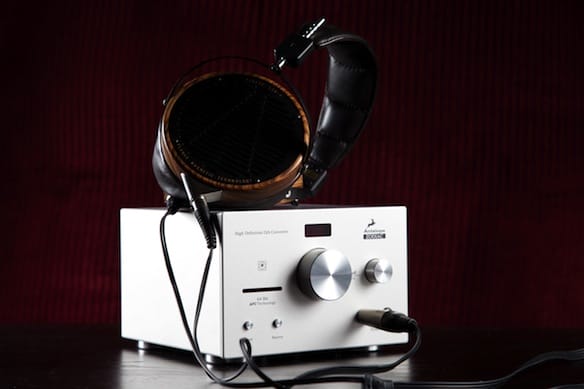
Image credit: Wired.
Headphone Amplifiers
Headphone amplifiers are standard equipment in any number of integrated amplifiers, digital-to-audio converters, preamps and music players. For our purposes we will be discussing stand-alone or outboard headphone amplifiers.
What differentiates a headphone amplifier from other audio power amplifiers is the power range, generally between 10mW and 2 Watts. By tailoring the amplification power to optimize headphone speaker response, input impedance is increased and output impedance decreased (in comparison to other power amplifiers) so that current is maximized in order to provide higher volume with less distortion. This provides a more accurate representation of the original sounds, ultimately raising fidelity over integrated amplifiers. As there are headphones that range from low to high sensitivity, some extreme cases of coupling a high sensitivity headphone with a high-wattage amplifier have been proven to cause damage to the ears.
In optimizing designs for headphones and headphone amplifiers, it was discovered that direct reproduction of stereo separation can cause discomfort in the listener, so there is a standard of bleeding a bit of right channel into the left, and vice versa, which alleviates this tension. This is known as crossfeeding, and is most commonly introduced in playing traditional vinyl recordings, though there are other professional applications. Using digital signal processors, designers have been able to effect a means by which to adjust crossfeed as well as to simulate many-speaker surround-sound systems through the two speakers of headphones. The standard configuration for a headphone amp is to plug it directly into the output stage of a power amplifier and plug the headphones directly it. The other emerging popular configuration is for computer-based audio sources and can be plugged directly into a USB port. As there are many commonalities between digital –audio converters, preamps, amplifiers and headphone amplifiers, we recommend you reference the Priceonomics Audiophile Guide reviews of these products.
In discussing the driving force behind headphone amplifiers, the power versus distortion issue, no discussion would be complete without mentioning high-power headphones. Electrostatic headphones were developed on the heels of electrostatic speakers, and like their larger counterparts, require higher output power stages. These developments represent a small portion of the audiophile market, to the point where they could be the subject of their own discussion.
There are so many different hybrids of headphone amps that it is difficult to compile a one-to -one analysis of stand-alone products. One of the more popular hybrids is the headphones amplifier/preamplifier/DAC, while another involves the use of vaccum tube technology at the input stage to warm and condition the actual speaker response.
The value associated with this diverse range of products is extreme, from $10 do-it-yourself kits to $2000 hybrid headphone amplifiers. The Fiio E5 or E6 represent the bottom of the line, with USB power, built-in volume controls and a two-stage equalizer to potentially boost bass response. They work with virtually any audio source and the compactness makes them ideal for portable players. They retail for under $30 and produce THD (total harmonic distortion) of less than .009%.
The Pro-Ject Head Box II is exclusively a headphones amplifier, classified as a low-distortion headphone amplifier. It has RCA stereo input and output jacks, and a standard ¼” headphone output jack, and produces THD less than .005% for a retail value of around $160.
Of course if one is considering a pair of Sennheiser HD 650 headphones, available under $400 or the Grado RS1i reference headphones, around $700, one might consider the higher end of the spectrum: The Burson Conductor Reference Class Amplifier HA-160D ($1850) is a hybrid DAC/preamp/Headphone Amplifier which is so versatile as to command its own article. It works with any power source, includes the 32-bit hyper-stream SABRE DAC chip as well as an asynchronous USB 24-bit/192 kHz (Tenor TE8802 receiver), coaxial and toslink inputs supporting 32-bit/192kHz audio files, and the standard array of RCA ins and outs. THD is listed at less than .03% at 30 ohms with 1 watt of output, with the DAC achieving a THD+N rating of less that .0005% at 1 kHz, 0dBFS.
It should be pointed out that the use of the word, “reference” in speakers, headphones, monitors or amplifiers is generally an indication that one is leaving the level of home audio and entering the realm of studio-quality gear. Priceonomics will help you make a selection that works for your needs and budget!



